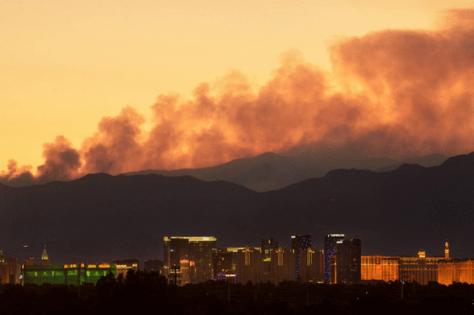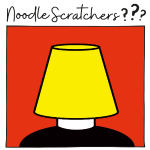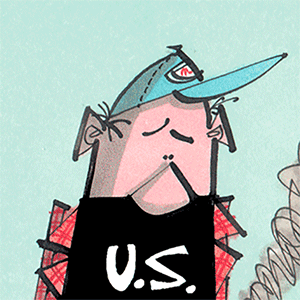After LA wildfires, could Las Vegas be next?
Published in News & Features
For most of the city’s relatively short history, residents of the Las Vegas Valley have been spared from the anguish of the often costly and deadly threat of wildfire.
Wildfire re-entered the American consciousness this year in a big way, when seven fires pummeled the Los Angeles area, killing at least 29 people and spurring economic losses totaling as much as $275 billion. It was a perfect storm of conditions that allowed for such widespread devastation — powerful winds, an abundance of vegetation that acted as fuel, and a lack of rain that dried out soils.
Though Las Vegas has physical and natural attributes working in its favor, large-scale wildfire is never out of the question, said Billy Samuels, acting fire chief of the Clark County Fire Department. And with climate change causing more favorable conditions for wildfire and fewer companies agreeing to insure Nevada homes than ever, valley residents should be paying attention.
“We should never think that it’s never going to happen here,” Samuels said in a recent interview. “But we always try to be prepared, and we always try to think of the worst-case scenario.”
How have experts quantified Las Vegas’ risk?
Several tools prepared by the public and private sector can clue Nevadans in to whether their property may be at risk of wildfire.
First Street, a company that models climate-change-related risk with interactive maps, labels 425,000 properties in Clark County as having at least some risk of being affected by wildfire over the next 30 years. The real estate brokerage Redfin places Las Vegas 12th on the list of the wildfire risk of all U.S. cities.
The Nevada Division of Forestry’s public data paints a similar picture, with the outer rings of Henderson and Summerlin having the most potential for wildfire over time. Studies show that climate change is an exacerbating factor, too, with drier and hotter conditions increasing the number of so-called fire weather days when wildfire is more likely.
But when it comes to the reality on the ground, facts and figures might not matter much. Kacey KC, Nevada’s fire warden and state forester, said wildfires don’t discriminate by risk assessments if a spark has the fuels to proceed.
“We’ve had large fires in areas identified as low risk,” KC said. “All the wrong conditions existed that day: Winds were wrong, or relative humidities were wrong. Once it starts moving from home to home, it’s really like an ember show and a question of, where is it going to find a receptive host?”
Las Vegas’ more ideal conditions
Many Nevadans have dismissed wildfire as more of an issue for rural areas like Mount Charleston or one more specific to Northern Nevada.
And for the most part, history has proven them right. A state map with all recorded wildfires since 1901 shows little to no impact, with the exception of some brush fires near Clark County Wetlands Park in eastern Las Vegas.
The story of Mount Charleston, however, is different. The Carpenter 1 fire in 2013 burned nearly 28,000 acres in the Spring Mountains range, caused by a lightning strike that came after three, 117-degree days in the valley and intense winds.
The densely wooded range is fire prone because of its topography, KC said. It’s one of 13 landscapes that Nevada has identified as a priority going forward when it comes to fire prevention efforts such as thinning out vegetation.
Because of the one-lane road that passes through residential areas of Mount Charleston, roads easily become clogged as emergency personnel funnel into the area. Similar concerns exist for more remote parts of the valley, she said.
“Should something like that happen — as it did in the Tahoe Basin and or down in Mount Charleston — communication is one of the first things to go,” KC said.
Samuels, of Clark County, said several factors work in the Las Vegas Valley’s favor when it comes to wildfire.
The hot and dry climate means less vegetation, he said. Rural areas have more hills and valleys, as well as stronger winds.
“We’re very blessed with our topography, our resources,” Samuels said. “We’re blessed with the collaboration of the community that we have with our private and public partners.”
Prevention remains key
Efforts are underway to increase the state’s resilience to wildfire, relying on many state agencies and neighboring states to aid Nevada in any emergency scenario.
KC’s department is pushing a bill through the Nevada Legislature this session that would allow Gov. Joe Lombardo to take advantage of existing interstate fire compacts. Nearly a dozen agencies, from the Bureau of Land Management to local fire departments, collaborate on both fire response and prevention.
Residents shouldn’t worry about water when it comes to wildfire in the Las Vegas Valley, said Bronson Mack, a spokesman for the Southern Nevada Water Authority.
The valley’s water districts retain about a billion gallons of water in reservoirs throughout Las Vegas, Henderson and North Las Vegas. Fire hydrants are checked regularly, and the entire system is gravity-fed, which is a plus in emergencies, Mack said.
“Even if there was some kind of a significant fire issue that impacted our ability to be able to pump water — be it damage to electrical facilities or damage to the pump stations themselves — these reservoirs will be able to continue to operate,” Mack said.
Clark County officials recommend that residents download the Southern Nevada Community Preparedness App as well as an app known as CodeRED, to get up-to-date notifications and warnings. They say having a communication plan for family members and having a kit at the ready with necessary medications is one way to prepare.
And if local fire districts across the Silver State need help to better prime their communities for emergencies, KC’s department is ready to help, she said.
“It feels overwhelming at times,” KC said. “You see things like California, and it makes you wonder: ‘Am I next? Could I be there?’ So, we’re here as references to help them try to navigate through that.”
©2025 Las Vegas Review-Journal. Visit reviewjournal.com.. Distributed by Tribune Content Agency, LLC.







Comments